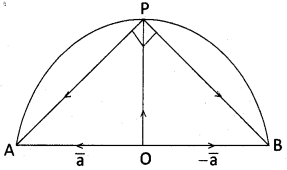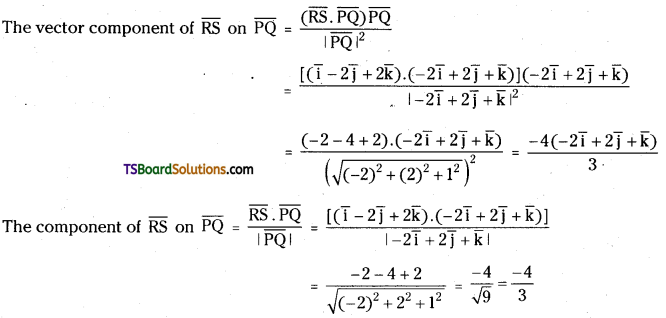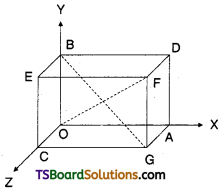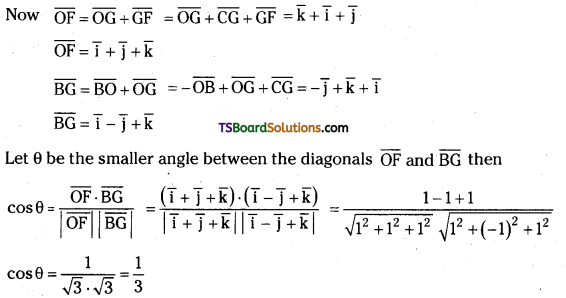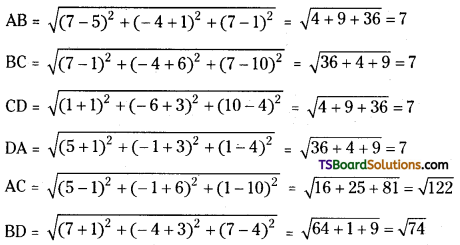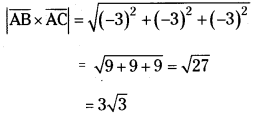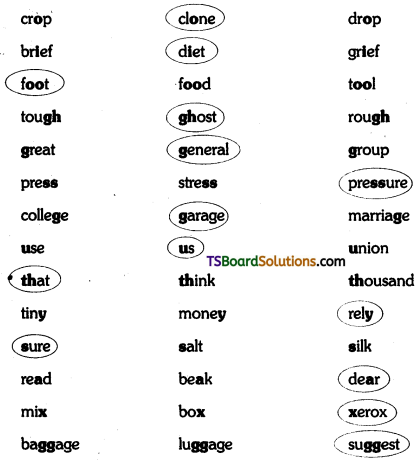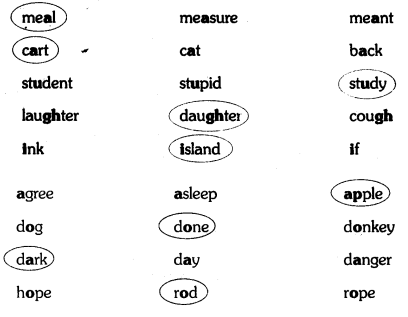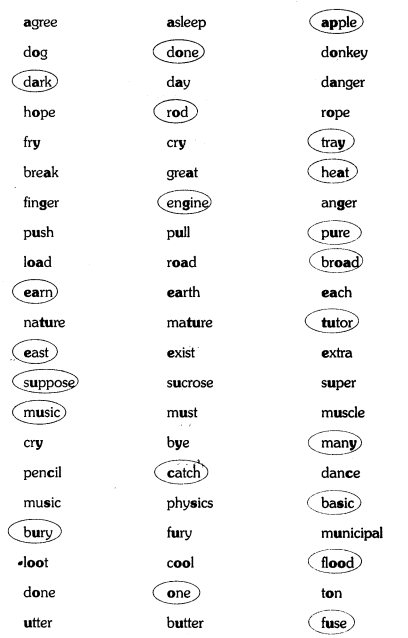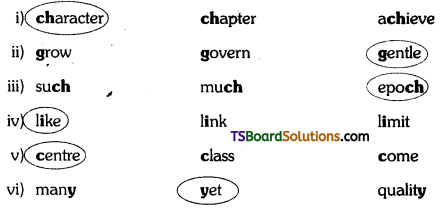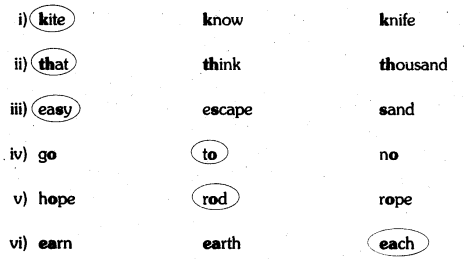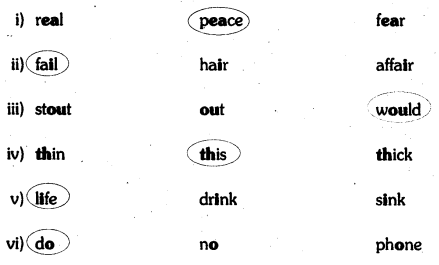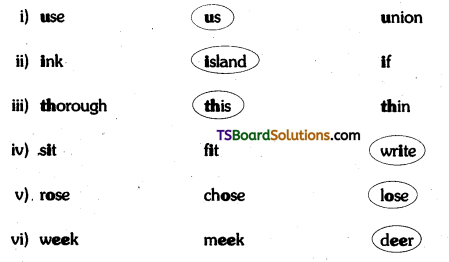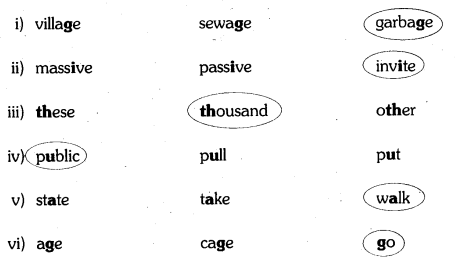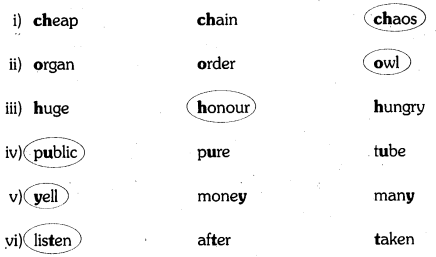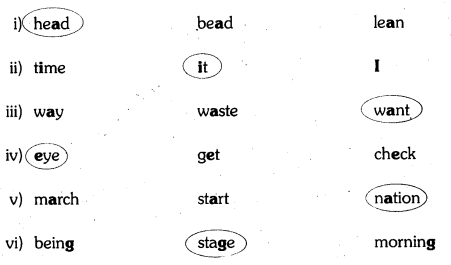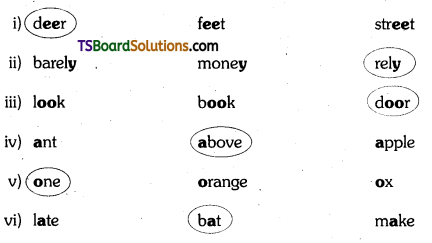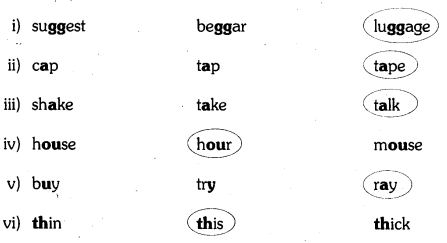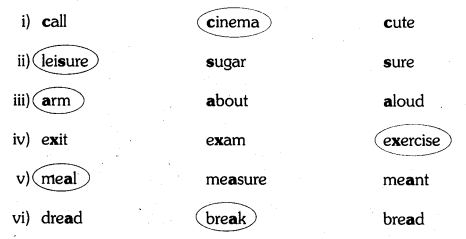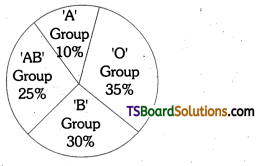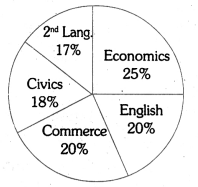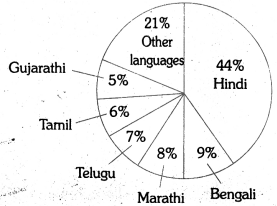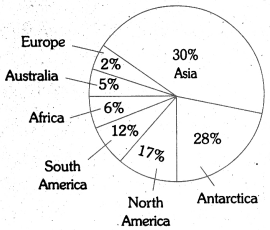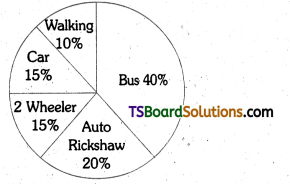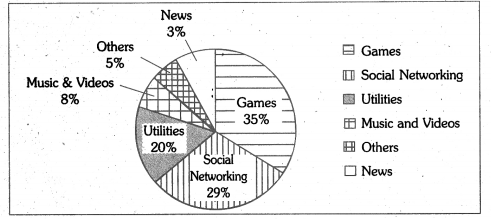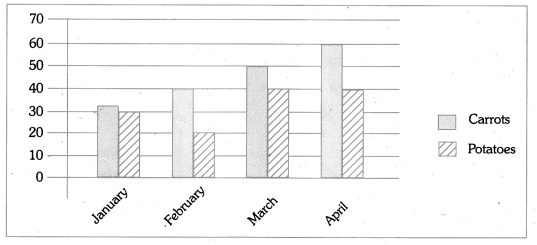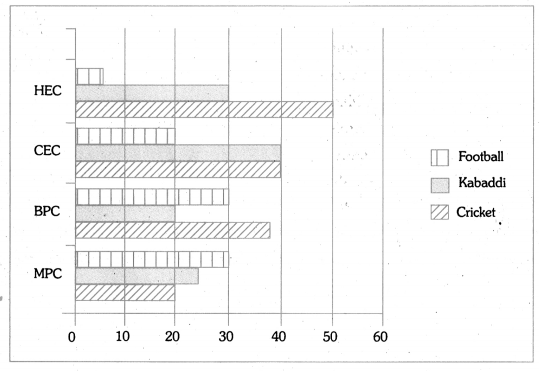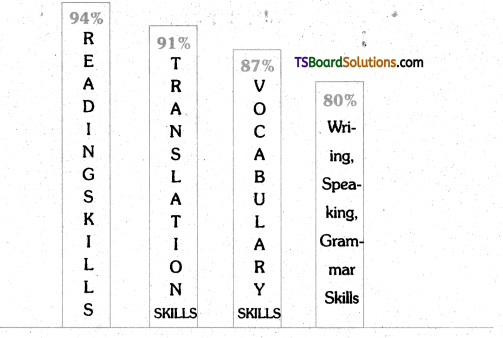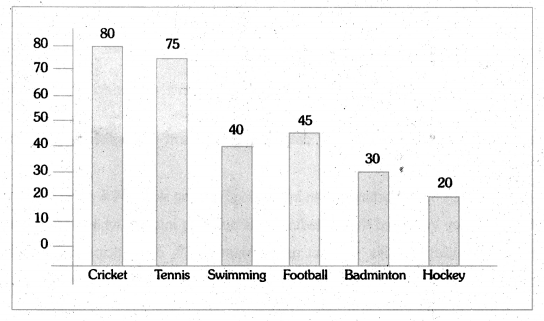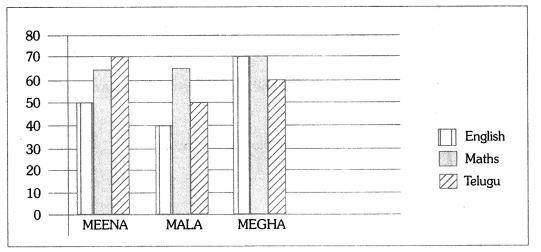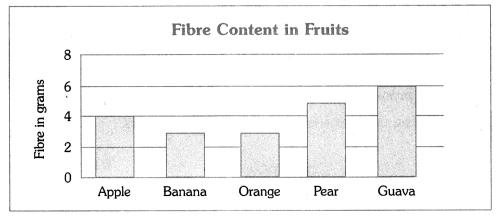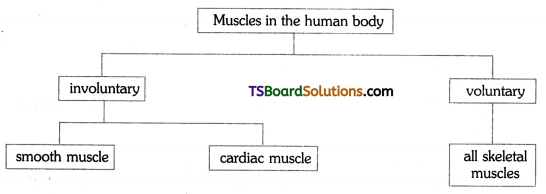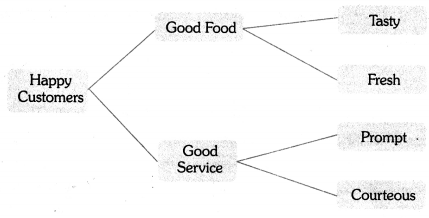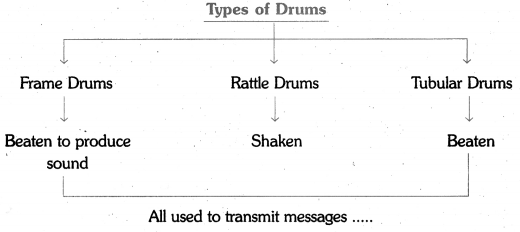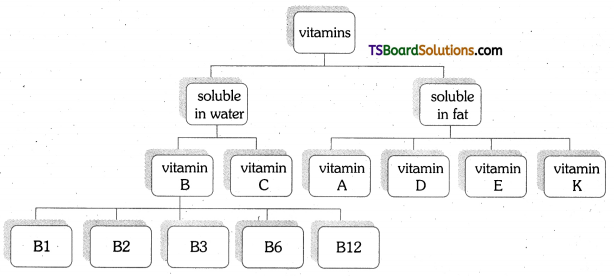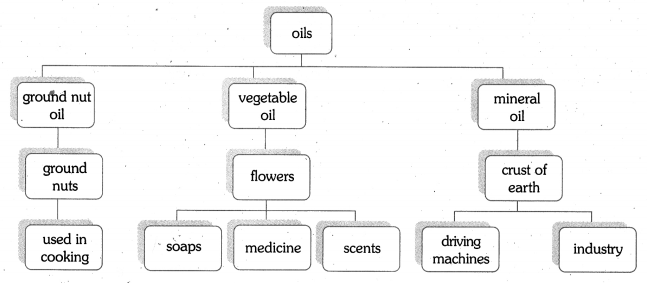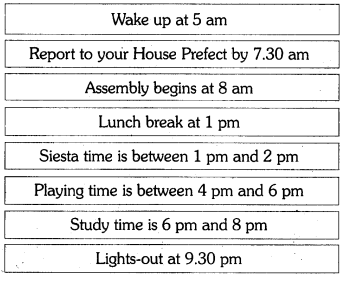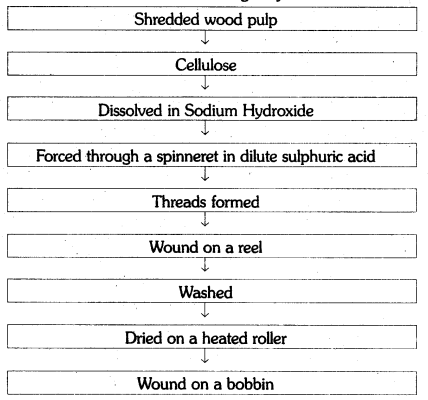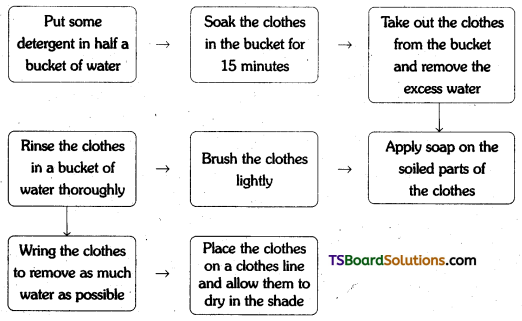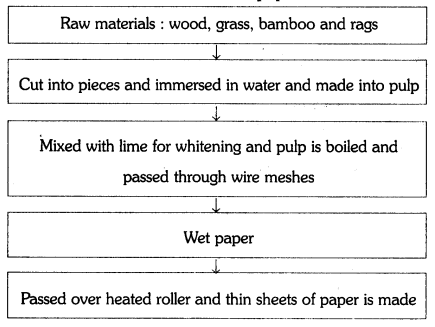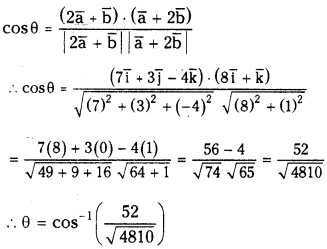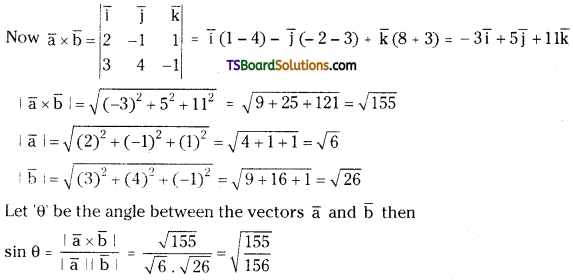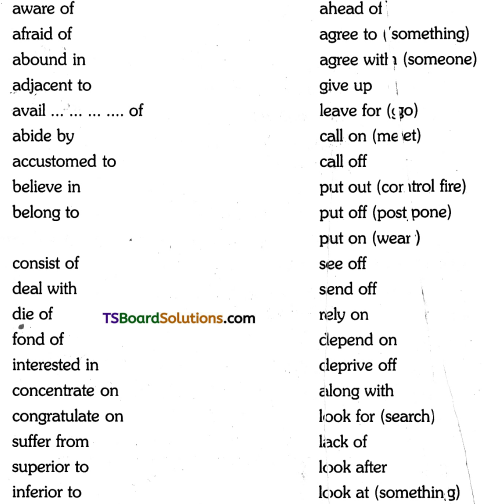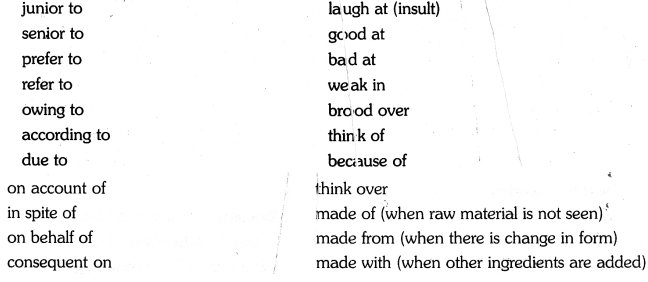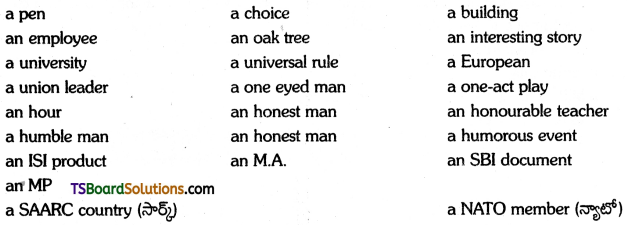Students must practice these Maths 2A Important Questions TS Inter Second Year Maths 2A Probability Important Questions Short Answer Type to help strengthen their preparations for exams.
TS Inter Second Year Maths 2A Probability Important Questions Short Answer Type
Question 1.
If four fair coins are tossed simultaneously then find the probability that two heads and 2 tails appear. [Mar. ’02, ,01]
Solution:
Let, S be the sample space.
4 coins are tossed simultaneously then total no. of ways = 24 = 16.
∴ n(S) = 16
Let, A be the event of getting two heads and two tails then n(A) = \({ }^4 C_2=\frac{4.3}{1.2}\) = 6
[HHTT, HTHT, HTTH, THTH, TTHH, THHT]
∴ Probability of getting 2 heads and 2 tails is P(A) = \(\frac{n(A)}{n(S)}=\frac{6}{16}=\frac{3}{8}\).
Question 2.
Find the probability that a non-leap year contains
I) 53 Sundays
II) 52 Sundays only [Mar. ’12, ’09]
Solution:
A non-leap year contains 365 days in which there are 52 weeks and one day extra.
52 weeks contains 52 × 7 = 364 days and
left out one day may be either Sunday, Mon, Tue, Wed, Thu, Fri or Sat.
∴ n(S) = 7
I) For a non-leap year to contain 53 Sundays, we have only one possibility to the have 365th day, a Sunday.
∴ n(A) = i
∴ Probability of getting 53 Sundays in a non-leap year is P(A) = \(\frac{\mathrm{n}(\mathrm{A})}{\mathrm{n}(\mathrm{S})}=\frac{1}{7}\)
II) For a non-leap year to contain 52 Sundays we have 6 possibilities for 365th day be a day other than Sunday.
∴ n(A) = 6
∴ Probability of getting 52 Sundays in a non-leap year is P(A) = \(\frac{\mathrm{n}(\mathrm{A})}{\mathrm{n}(\mathrm{S})}=\frac{6}{7}\).

Question 3.
For any two events A and B show that P(\(\mathbf{A}^c \cap \mathbf{B}^{\mathrm{c}}\)) = 1 + P(A ∩ B) – P(A) – P(B). [March ’05]
Solution:
Let A, B are any two sets.
then \(\mathbf{A}^c \cap \mathbf{B}^{\mathrm{c}}\) = \((A \cup B)^c\)
LHS = \(\mathrm{P}\left(\mathrm{A}^{\mathrm{c}} \cap \mathrm{B}^{\mathrm{c}}\right)\)
= \(\left[(A \cup B)^c\right]\)
= 1 – P(A ∪ B)
= 1 – [P(A) + P(B) – P(A ∩ B)]
= 1 + P(A ∩ B) – P(A) – P(B) = RHS
∴ \(\mathrm{P}\left(\mathrm{A}^{\mathrm{c}} \cap \mathrm{B}^{\mathrm{c}}\right)\) = 1 + P(A ∩ B) – P(A) – P(B).
Question 4.
Two persons A and B are rolling a die on the condition that the person who gets 3 will win the game. If A starts the game, then find the probabilities of A and respectively to win the game. [TS – May 2015; Board Paper]
Solution:
Two persons A and B rolling a die.
P = Probability of getting 3 = \(\frac{1}{6}\)
q = 1 – p
= 1 – \(\frac{1}{6}\) = \(\frac{5}{6}\)
Probability of success, P = \(\frac{1}{6}\)
Probability of failure, q = \(\frac{5}{6}\)
‘A’ may win the game in either in I trial or in III trial or V trial etc.
Probability of A win = p + qqp + qqqqp + …………..
= p + q2p + q4p + …………..
= p(1 + q2 + q4 + …………….. )
= p\(\left(\frac{1}{1-q^2}\right)\) (∵ S∞ = \(\frac{a}{1-r}\))
= \(\frac{p}{1-q^2}\)
= \(\frac{\frac{1}{6}}{1-\frac{25}{36}}=\frac{\frac{1}{6}}{\frac{36-25}{36}}=\frac{\frac{1}{6}}{\frac{11}{36}}=\frac{6}{11}\)
Probability of B win = 1 – P(A)
P(B) = 1 – \(\frac{6}{11}\) = \(\frac{5}{11}\)
P(A) = \(\frac{6}{11}\),
∴ P(B) = \(\frac{5}{11}\)
Question 5.
A, B, C are three newspapers from a city. 20% of the population read A, 16% read B, 14% read C, 8% both A and B, 5% both A and C, 4% both B and C and 2% all the three. Find the percentage of the population who read atleast one newspaper.
Solution:
A, B, C are three newspapers from a city.
Given, P(A) = \(\frac{20}{100}\)
P(B) = \(\frac{16}{100}\)
P(C) = \(\frac{14}{100}\)
P(A ∩ B) = \(\frac{8}{100}\)
P(B ∩ C) = \(\frac{4}{100}\)
P(C ∩ A) = \(\frac{5}{100}\)
P(A ∩ B ∩ C) = \(\frac{2}{100}\)
∴ The percentage of the population who read atleast one newspaper,
P(A ∪ B ∪ C) = P(A) + P(B) + P(C) – P(A ∩ B) – P(B ∩ C) – P(A ∩ C) + P(A ∩ B ∩ C)
= \(\frac{20}{100}+\frac{16}{100}+\frac{14}{100}-\frac{8}{100}-\frac{4}{100}-\frac{5}{100}+\frac{2}{100}\)
= \(\frac{20+16+14-8-4-5+2}{100}=\frac{35}{100}\)
∴ 35% readers read atleast one newspaper.

Question 6.
If two numbers are selected randomly from 20 consecutIve natural numbers. Find the probability that the sum of the two numbers is
I) an even number
II) an odd number. [March 2008]
Solution:
Let, S be the sample space.
No. of ways of selecting 2 numbers from 20 numbers
n(S) = \({ }^{20} C_2=\frac{20 \times 19}{1 \times 2}\) = 190
I) Let, A be the event that the sum of the numbers is even. When two numbers are selected at random from 20 consecutive natural numbers.
Since, the sum of two numbers is even if the numbers are both even or both odd.
∴ n(A) = \({ }^{10} C_2+{ }^{10} C_2\)
= \(\frac{10 \times 9}{2 \times 1}+\frac{10 \times 9}{2 \times 1}\)
= 45 + 45 = 90
II) The probability that the sum of 2 numbers is odd = probability of \(\overline{\mathrm{A}}\)
= P(\(\overline{\mathrm{A}}\)) = 1 – P(A)
= 1 – \(\frac{9}{19}\)
= \(\frac{10}{19}\) OR
The sum of two numbers is odd if one is even and the other number is odd.
n(\(\overline{\mathrm{A}}\)) = \({ }^{10} \mathrm{C}_1 \cdot{ }^{10} \mathrm{C}_1\) = 100
P(\(\overline{\mathrm{A}}\)) = \(\frac{n(\bar{A})}{n(S)}=\frac{100}{190}=\frac{10}{19}\)
Question 7.
The probability for a contractor to get a road contract is \(\frac{2}{3}\) and to get a building contract is \(\frac{5}{9}\). The probability to get atleast one contract is \(\frac{4}{5}\). Find the probability that he get both the contracts. [TS – Mar. 2019; AP – Mar. 2016]
Solution:
Let A is the event of getting a road contract.
B is the event of getting a building contract.
Given, the probability for a contractor to get a road contract is P(A) = \(\frac{2}{3}\)
The probability for a contractor to get a building contract is P(B) = \(\frac{5}{9}\)
The probability to get atleast one contract is P (A ∪ B)= \(\frac{4}{5}\)
The probabiLity that he gets both the contracts is P(A ∪ B) = ?
By addition on probability,
P(A ∪ B) = P(A) P(B) – P(A ∩ B)
\(\frac{4}{5}\) = \(\frac{2}{3}\) + \(\frac{5}{9}\) – P(A ∩ B)
P(A ∩ B) = \(\frac{2}{3}+\frac{5}{9}-\frac{4}{5}=\frac{11}{9}-\frac{4}{5}\)
= \(\frac{55-36}{45}=\frac{19}{45}\).

Question 8.
In a committee of 25 members, each member is proficient either in mathematics or in statistics or in both. If 19 of these are proficient in mathematics, 16 in Statistics, find the probability that a person selected from the committee is proficient in both. [TS – Mar. 2016; Mar. ‘94]
Solution:
Let, ‘S be the sample space.
When a person is choosen at random from committee consisting of 25 members then
n(S) = \({ }^{25} \mathrm{C}_1\) = 25
Let, A be the event that the person is proficient in mathematics n(A) = \({ }^{19} \mathrm{C}_1\) = 19
∴ P(A) = \(\frac{n(A)}{n(S)}=\frac{19}{25}\)
Let, B be the event that the person is proficient in statistics n(B) = \({ }^{16} \mathrm{C}_1\) = 16
∴ P(B) = \(\frac{n(B)}{n(S)}=\frac{16}{25}\)
[Since, 19 are proficient in mathematics and 16 are proficient in statistics]
Since, everyone is either proficient in mathematics or statistics or both then A ∪ B = S
P(A ∪ B) = P(S)
P(A ∪ B) = 1
P(A) + P(B) – P(A ∩ B) = 1
\(\frac{19}{25}+\frac{16}{25}\) – P(A ∩ B) = 1
\(\frac{35}{25}\) – P (A ∩ B) = 1
\(\frac{7}{5}\) – P (A ∩ B) = 1
∴ P (A ∩ B) = \(\frac{7}{5}\) – 1 = \(\frac{2}{5}\).
Question 9.
A, B, C are 3 horses in a race. The probability of A to win the race is twice that of B, and probability of B is twice that of C. What are the probabilities of A, B and C to win the race? [TS- Mar. ‘18 March 14, ‘13, ‘99; May ‘14, ’09, 07; AP – Mar. ’19]
Solution:
Let A. B, C be the events that the horses A, B, C win the race respectively.
Given that, the probability of A to win the race is twice that of B.
∴ P(A) = 2P(B)
⇒ P(B) = \(\frac{1}{2}\) [P(A)]
The probability of B to win the race is twice that of C.
P(B) = 2P(C)
⇒ P(C) = [P(B)]
= \(\frac{1}{2}\) [\(\frac{1}{2}\) [P(A)]]
= \(\frac{1}{4}\) [P(A)]
Since, the horses A, B and C run the race A ∪ B ∪ C = S and A, B, C are mutually disjoint.
P(A ∪ B ∪ C) = P(S)
P(A ∪ B ∪ C) = 1
P(A) + P(B) + P(C) =1
P(A) + \(\frac{1}{2}\) P(A) + \(\frac{1}{4}\) P(A) = 1
P(A) [1 + \(\frac{1}{2}\) + \(\frac{1}{4}\)] = 1
P(A) [latex]\frac{4+2+1}{4}[/latex] = 1
P(A) \(\frac{7}{4}\) = 1
P(A) = \(\frac{4}{7}\)
P(A) = \(\frac{1}{2}\) P(A)
= \(\frac{1}{2} \times \frac{4}{7}=\frac{2}{7}\)
∴ P(B) = \(\frac{2}{7}\)
P(C) = \(\frac{1}{4}\) P(A)
= \(\frac{1}{4} \times \frac{4}{7}=\frac{1}{7}\)
P(C) = \(\frac{1}{7}\)
∴ P(A) = \(\frac{4}{7}\), P(B) = \(\frac{2}{7}\), P(C) = \(\frac{1}{7}\).

Question 10.
A bag contaIns 12 two rupee coins, 7 one rupee coins and 4 half rupee coins. If three coins are selected at random, then find the probability that
I) the sum of 3 coins is maximum
II) the sum of 3 coins is minimum
III) each coin is of different value. [March ‘07]
Solution:
In a bag, there are 12 two rupee coins, 7 one rupee coins and 4 half rupee coins.
Total no. of coins = 12 + 7 + 4 = 23
Let, ‘S’ be the sample space.
Total no. of ways of drawing 3 coins from 23 coins is n(S) = \({ }^{23} \mathrm{C}_3\)
I) We get maximum amount with the coins of two rupee coins.
∴ No. of ways of drawing 3 two rupee coins = \({ }^{12} \mathrm{C}_3\)
∴ n(A) = \({ }^{12} \mathrm{C}_3\)
∴ P(A) = \(\frac{\mathrm{n}(\mathrm{A})}{\mathrm{n}(\mathrm{S})}=\frac{{ }^{12} \mathrm{C}_3}{{ }^{23} \mathrm{C}_3}\)
II) We get minimum amount if 3 coins are half rupee coins.
∴ No. of ways of drawing 3-half rupee coins = \({ }^4 \mathrm{C}_3\)
∴ n(B) = \({ }^4 \mathrm{C}_3\)
∴ P(B) = \(\frac{\mathrm{n}(\mathrm{B})}{\mathrm{n}(\mathrm{S})}=\frac{{ }^4 \mathrm{C}_3}{{ }^{23} \mathrm{C}_3}\)
III) Each coin is of different value then we must draw one coin in each.
This can be done in \({ }^{12} \mathrm{C}_1 \cdot{ }^7 \mathrm{C}_1 \cdot{ }^4 \mathrm{C}_1\) ways
∴ n(C) = \({ }^{12} \mathrm{C}_1 \cdot{ }^7 \mathrm{C}_1 \cdot{ }^4 \mathrm{C}_1\)
= 12 × 7 × 4
∴ P(C) = \(\frac{n(C)}{n(S)}=\frac{12 \times 7 \times 4}{{ }^{23} C_3}\)
Question 11.
Two dice are thrown. Find the probability of getting the same iiumber ou both the faces.
Solution:
Let, ‘S’ be the sample space.
The total no.of ways of rolling two dice is n(S) = 62 = 36
Let A be the event of getting the same number on both the faces of the two dice then A = {(1, 1), (2, 2), (3, 3), (4, 4), (5, 5), (6, 6)}
∴ n(A) = 6
∴ The probability of getting the same number on both the face
P(A) = \(\frac{\mathrm{n}(\mathrm{A})}{\mathrm{n}(\mathrm{S})}=\frac{6}{36}=\frac{1}{6}\).
Question 12.
An integer is picked from 1 to 20, both inclusive. Find the probability that is a prime.
Solution:
Let ‘S’ be the sample space.
Total no.of ways of selecting one number from 20 numbers is n(S) = \({ }^{20} \mathrm{C}_1\) = 20
Let, A be the event of getting a prim number then A = {2, 3, 5, 7, 11, 13, 17, 19}
∴ n(A) = 8
∴ The probability of a selected number be a prime is P(A) = \(\frac{n(A)}{n(S)}=\frac{8}{20}=\frac{2}{5}\).

Question 13.
A bag contains 4 red balls, 5 black balls and 6 blue balls. Find the probability that 2 balls drawn at random simultaneously from the black are a red and black ball.
Solution:
Let, S be the sample space.
Total no.of balls = 15 (4 + 5 + 6)
Total no.of ways of drawing 2 balls from 15 balls is
n(S) = \({ }^{15} \mathrm{C}_2\)
= \(\frac{15.14}{2 \times 1}\)
= 15 × 7 = 105
Let, A be the event of getting a red and a black ball in a draw.
n(A) = \({ }^4 \mathrm{C}_1 \cdot{ }^5 \mathrm{C}_1\)
= 4 × 5 = 20
∴ Required probability, P(A) = \(\frac{n(A)}{n(S)}=\frac{20}{105}=\frac{4}{21}\).
Question 14.
Ten dice are thrown. Find the probability that none of the dice shows the number one.
Solution:
Let, S be the sample space that ten dice are rolled.
n(S) = 6.6 ………….. 6 (10 times) = 610
Let, A be the event of not getting a number 1 on the face of the dice.
n(A) = 5 . 5 …………………. 5 (10 times) = 510
Required probability, P(A) = \(\frac{n(A)}{n(S)}=\frac{5^{10}}{6^{10}}=\left(\frac{5}{6}\right)^{10}\)
Question 15.
A number ‘x’ is drawn arbitrarly from the set {1, 2, ……………. 100}. Find the Probability that x + \(\frac{1}{x}\) is greater than 29. [AP – May 2015]
Solution:
Let, S be the sample space.
Total no. of ways of selecting one number from 100 numbers is
n(S) = \({ }^{100} \mathrm{C}_1\) = 100
Let A be the event that x is selected at random from the set,
S = {1, 2, 3 , …………………, 100} has the property
x + \(\frac{100}{x}\) > 29
\(\frac{x^2+100}{x}\) > 29
x2 + 100 > 29x
x2 – 29x + 100 > 0
x2 – 4x – 25x + 100 > 0
x (x – 4) – 25 (x – 4) > 0
(x – 4) (x – 25) > 0
x < 4 or x > 25
∴ A = {1, 2, 3, 26, 27, …………….., 100}
n(A) = 78
∴ Required probability, P(A) = \(\frac{\mathrm{n}(\mathrm{A})}{\mathrm{n}(\mathrm{S})}=\frac{78}{100}\) = 0.78.

Question 16.
A fair coin is tossed 200 times. Find the probability of getting a head an odd number of times.
Solution:
Let, S be the sample space.
The total no.of ways a fair coin is tossed 200 times.
n(S) = 2200
Let, A be the event of getting a head an odd number of times then
n(A) = \(200 c_1+200 c_3+200 c_5+\ldots \ldots \ldots+200 c_{199}\)
= 2100-1 [2n-1]
= 2199
∴ Required probability, P(A) = \(\frac{\mathrm{n}(\mathrm{A})}{\mathrm{n}(\mathrm{S})}=\frac{2^{199}}{2^{200}}=\frac{1}{2}\).
Question 17.
A and B are among 20 persons who sit at random along a round table. Find the probability that there are any 6 persons
between A and B.
Solution:
Let S be the sample space.
Let A occupy any seat at the round table then there are 19 seats left for B.
∴ n(S) = 19
Let E be the event if 6 persons are to be seated between A and B then B has only two ways to sit.
∴ Required probability, P(A) = \(\frac{n(A)}{n(S)}=\frac{2}{19}\)
Question 18.
Out of 30 consecutive Integers, two integers are drawn at random. Find the probability that their sum is odd.
Solution:
Let S’ be the sample space.
The total no. of ways of choosing two integers out of 30 is n(S) = \({ }^{30} \mathrm{C}_2\)
Out of the 30 numbers, 15 are even and 15 are odd.
If the sum of the two numbers is to be odd, one should be even and other is odd.
Hence, the no.of cases favourable to the required event is n(A) = \({ }^{15} \mathrm{C}_1 \cdot{ }^{15} \mathrm{C}_1\)
∴ The required probability, P(A) = \(\frac{\mathrm{n}(\mathrm{A})}{\mathrm{n}(\mathrm{S})}=\frac{{ }^{15} \mathrm{C}_1 \cdot{ }^{15} \mathrm{C}_1}{{ }^{30} \mathrm{C}_2}=\frac{\frac{15.15}{30 \times 29}}{2 \times 1}=\frac{15}{29}\).

Question 19.
Find the probability of throwing a total score of 7 with two dice. [May ’08]
Solution:
Let, S be the sample space.
The total no. of ways of rolling two dice
∴ n(S) = 62 = 36
Let, A’ be the event of getting a total score of 7 with two dice then
A = {(1, 6), (2, 5), (3, 4), (4, 3), (5, 2), (6, 1)}
∴ n(A) = 6
∴ Probability of throwing a total score of 7 with 2 dice is P(A) = \(\frac{\mathrm{n}(\mathrm{A})}{\mathrm{n}(\mathrm{S})}=\frac{6}{36}=\frac{1}{6}\).
Question 20.
Find the probability of obtaining two tails and one head when three coins are tossed.
Solution:
Let, S be the sample space.
The total no. of ways three coins are tossed,
S = {HHH, HHT, HTH, THH, HTT, THT, TTH, TTT}
∴ n(S) = 8
Let, A be the event of getting two tails and a head when three coins are tossed then
A = {HTT, THT, TTH}
∴ n(A) = 3
∴ The required probability, P(A) = \(\frac{n(A)}{n(S)}=\frac{3}{8}\).
Question 21.
A page is opened at random from a book containing 200 pages. What is the prob ability that the number oil the page is a perfect square? [May ’12]
Solution:
Let, S be the sample space.
The total no.of ways selecting a page from 200 pages is n(S) = \({ }^{200} \mathrm{C}_1\) = 200
Let A be the event of drawing a page whose number is a perfect square.
A = {12, 22, 32, 42, 52, 62, 72, 82, 92, 102, 112, 122, 132, 142}
∴ n(A) = 14
∴ Required probability, P(A) = \(\frac{\mathrm{n}(\mathrm{A})}{\mathrm{n}(\mathrm{S})}=\frac{14}{200}=\frac{7}{100}\).

Question 22.
Find the probability of drawing an ace or a spade from a well – shuffled pack of 52 playing cards. [TS – Mar. 2015]
Solution:
Let, S be the sample space.
Total no. cards in the pack = 52
∴ n(S) = \({ }^{52} \mathrm{C}_1\) = 52
If A is the event of getting an ace card then
n(A) = \({ }^4 \mathrm{C}_1\) = 4
∴ Probability of getting an ace card,
P(A) = \(\frac{\mathrm{n}(\mathrm{A})}{\mathrm{n}(\mathrm{S})}=\frac{4}{52}=\frac{1}{13}\)
If B is the event of getting a spade card then n(B) = \({ }^{13} \mathrm{C}_1\) = 13
∴ Probability of getting a spade card,
P(B) = \(\frac{n(B)}{n(S)}=\frac{13}{52}=\frac{1}{4}\)
A ∩ B is common to the events A, B. There is a spade, ace.
∴ n(A ∩ B) = \({ }^1 C_1\) = 1
probability of getting A ∩ B is P(A ∩ B) = \(\frac{n(A \cap B)}{n(S)}=\frac{1}{52}\)
By addition theorem on probability,
P(A ∪ B) = P(A) + P(B) – P(A ∩ B)
= \(\frac{1}{13}+\frac{1}{4}-\frac{1}{52}\)
= \(\frac{4+13-1}{52}=\frac{8}{52}=\frac{4}{13}\)
Question 23.
A and B are events with P(A) 0.5, P(B) = 0.4 and P(A ∩ B) = 0.3. Find the probability that
I) A does not occurs
II) Neither A nor B occurs [AP – Mar. ‘18, TS – Mar.’17 March ‘10]
Solution:
A and B are two events
Given that, P(A) = 0.5.
P(B) = 0.4, P(A ∩ B) = 0.3
I) The probability that A does not occur = P(\(\overline{\mathrm{A}}\))
= 1 – P(A)
= 1 – 0.5 = 0.5.
II) The probability that neither A nor B occurs = \(P(A \cup B)^C\)
= 1 – P(A ∪ B)
= 1 – [P(A) + P(B) – P(A ∩ B)]
= 1 – [0.5 + 0.4 – 0.3]
= 1 – 0.6 = 0.4.
Question 24.
If A, B, C are three events, show that P(A ∪ B ∪ C) = P(A) + P(B) + P(C) – P(A ∩ B) – P(B ∩ C) – P(C ∩ A) + P(A ∩ B ∩ C). [AP – Mar. 2015, AP – May 2016]
Solution:
A, B, C are three events
L.H.S = P(A ∪ B ∪ C)
= P(A) + P(B ∪ C) – P[A ∩ (B ∪ C)]
= P(A) + P(B) + P(C) – P(B ∩ C) – P[(A ∩ B) ∪ (A ∩ C)]
= P(A) + P(B) + P(C) – P(B ∩ C) – [P(A ∩ B) + P(A ∩ C) – P[(A ∩ B) ∩ (A ∩ C)]]
= P(A) + P(B) + P(C) – P(B ∩ C) – P(A ∩ B) – P(C ∩ A) + P(A ∩ B ∩ C)
= P(A) + P(B) + P(C) – P(A ∩ B) – P(B ∩ C) – P(C ∩ A) + P(A ∩ B ∩ C)
= RHS
∴ P(A ∪ B∪ C) = P(A) + P(B) + P(C) – P(A ∩ B) – P(B ∩ C) – P(C ∩ A) + P(A ∩ B ∩ C).

Question 25.
Three screws are drawn at random from a lot of 50 screws, five of which are defective. Find the probability of the event that all 3 screws are nondefective. Assuming that the drawing is
a) with replacement
b) without replacement.
Solution:
Let, ‘S’ be the sample space.
The total no. of screws = 50
The no.of defective screws = 5
The no.of non-defective screws = 45
Let A be the event of getting 3 screws which are non-defective.
a) With replacement:
P(A) = \(\frac{{ }^{45} \mathrm{C}_1}{{ }^{50} \mathrm{C}_1} \cdot \frac{{ }^{45} \mathrm{C}_1}{{ }^{50} \mathrm{C}_1} \cdot \frac{{ }^{45} \mathrm{C}_1}{{ }^{50} \mathrm{C}_1}\)
= \(\frac{45}{50} \cdot \frac{45}{50} \cdot \frac{45}{50}=\left(\frac{9}{10}\right)^3\)
∴ P(A) = \(\left(\frac{9}{10}\right)^3\)
b) without replacement:
P(A) = \(\frac{{ }^{45} \mathrm{C}_1}{{ }^{50} \mathrm{C}_1} \cdot \frac{{ }^{44} \mathrm{C}_1}{{ }^{49} \mathrm{C}_1} \cdot \frac{{ }^{43} \mathrm{C}_1}{{ }^{48} \mathrm{C}_1}\)
= \(\frac{45}{50} \cdot \frac{44}{49} \cdot \frac{43}{48}=\frac{1419}{1960}\)
Question 26.
There are 3 black and 4 white balls in one bag, 4 black and 3 whIte balls In the second bag A die is rolled and the first bag is selected if the die shows up 1 or 3, and the second bag for the rest. Find the probability of drawing a black ball from the bag thus selected. [March ‘09]
Solution:
Probability of selecting I bag = \(\frac{2}{6}=\frac{1}{3}\)
Probabthty of selecting II bag 1 – \(\frac{1}{3}\) = \(\frac{2}{3}\)
Probability of getting a black ball from I bag = \(\frac{{ }^3 \mathrm{C}_1}{{ }^7 \mathrm{C}_1}=\frac{3}{7}\)
Probability of getting a black ball from II bag = \(\frac{{ }^4 \mathrm{C}_1}{{ }^7 \mathrm{C}_1}=\frac{4}{7}\)
∴ The probability of drawing a black ball = \(\frac{1}{3} \cdot \frac{3}{7}+\frac{2}{3} \cdot \frac{4}{7}\)
= \(\frac{1}{7}+\frac{8}{21}\)
= \(\frac{3+8}{21}=\frac{11}{21}\).
Question 27.
A, B, C are aiming to shoot a balloon. A will succeed 4 times out of 5 attempts. The chance of B to shoot the balloori is 3 out of 4 and that of C is 2 out of three. If the 3 aim the balloon simultaneously, then find the probability that atleast two of them hit the balloon.
Solution:
Given that,
P(A) = \(\frac{4}{5}\), P(B) = \(\frac{3}{4}\), P(C) = \(\frac{2}{3}\)
P(\(\overline{\mathrm{A}}\)) = 1 – P(A)
= 1 – \(\frac{4}{5}\) = \(\frac{1}{5}\)
P(\(\overline{\mathrm{B}}\)) = 1 – P(B)
= 1 – \(\frac{3}{4}\) = \(\frac{1}{4}\)
P(\(\overline{\mathrm{C}}\)) = 1 – P(C)
= 1 – \(\frac{2}{3}\) = \(\frac{1}{3}\)
∴ The probability that at least two of them hit balloon is equal to the probability of A, B hits the balloon then C will not hit or the probability of A, C hits the balloon then B will not hit or the probability of B. C hits the balloon then A will
not hit or the probability of all the three will hit the balloon.
= P(A ∩ B ∩ \(\overline{\mathrm{C}}\)) + P(A ∩ \(\overline{\mathrm{B}}\)∩ C) + P(\(\) ∩ B ∩ C) + P(A ∩ B ∩ C)
= P(A) . P(B). P(\(\overline{\mathrm{C}}\)) + P(A). P(\(\overline{\mathrm{B}}\)) . P(C) + P(\(\overline{\mathrm{A}}\)) . P(B) P(C) + P(A) + P(B) . P(C)
= \(\frac{4}{5} \cdot \frac{3}{4} \cdot \frac{1}{3}+\frac{4}{5} \cdot \frac{1}{4} \cdot \frac{2}{3}+\frac{1}{5} \cdot \frac{3}{4} \cdot \frac{2}{3}+\frac{4}{5} \cdot \frac{3}{4} \cdot \frac{2}{3}\)
= \(\frac{1}{5}+\frac{2}{15}+\frac{1}{10}+\frac{2}{5}=\frac{6+4+3+12}{30}=\frac{25}{30}=\frac{5}{6}\).

Question 28.
If A, B are two events, then show that \(\mathbf{P}\left(\frac{A}{B}\right) \cdot P(B)+P\left(\frac{A}{B^C}\right) \mathbf{P}\left(B^C\right)=P(A)\)
Solution:
A, B are two events.
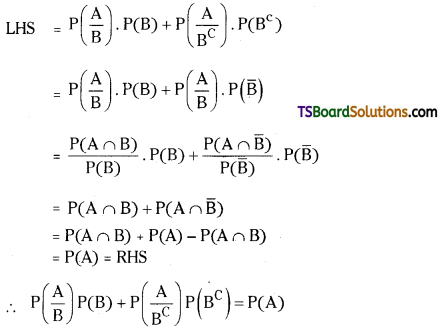
Question 29.
A pair of dice is rolled. What is the probability that their sum to 7 ? Give thatneither dice shows a 2.
Solution:
Let S be the sample space.
Let S does not shows 2 then S = 25
S = {(1, 1), (1, 3), (1, 4), (1, 5), (1, 6), (4, 1), (4, 3), (4, 4), (4, 5), (4, 6), (3, 1), (3, 3), (3, 4), (3, 5), (3, 6), (5, 1), (5, 3), (5, 4),
(5, 5), (5, 6), (6. 1), (6, 3), (6, 4), (6, 5), (6, 6)}
∴ n(S) = 25
Let A be the event that the sum to 7 one the pair of dice.
A = {(1, 6), (3, 4), (4, 3), (6, l)}
∴ n(A) = 4
∴ Required probability, P(A) = \(\frac{n(A)}{n(S)}=\frac{4}{25}\).
Question 30.
A pair of dice is rolled. What is the probability that neither dice shows 2?
Solution:
Given that S is the sum to 7.
Let S be the sample space.
Let S be the sum to 7.
When two dies are rolled,
S = {(l, 6), (2,5), (3,4), (4, 3), (5, 2), (6, 1)}
∴ n(S) = 6
Let A be the event that neither of dice shows 2.
A = {(1, 6), (3, 4), (4, 3), (6, 1)}
∴ n(A) = 4
∴ Required probability, P(A) = \(\frac{n(A)}{n(S)}=\frac{4}{6}=\frac{2}{3}\)
Question 31.
An urn contains 12 red balls and 12 green balls. Suppose 2 balls are drawn one after another without replacement. Find the probability that the second ball drawn is green. The first ball drawn is red ball.
Solution:
Let, S be the sample space.
The total no.of balls, n(S) = 24
Let, A be the event of drawing a red ball
n(A) = \({ }^{12} \mathrm{C}_1\) = 12
The probability of drawing a red in the first attempt
P(A) = \(\frac{n(A)}{n(S)}=\frac{12}{24}=\frac{1}{2}\)
Now, there are 23 balls remaining.
∴ n(S) = 23
Let \(\frac{B}{A}\) be the event of drawing a green in the second attempt \(n\left(\frac{B}{A}\right)={ }^{12} C_1\) = 12
∴ Required probability, \(P\left(\frac{B}{A}\right)=\frac{n\left(\frac{B}{A}\right)}{n(S)}=\frac{12}{23}\).

Question 32.
If one card is drawn at random from a pack of cards then show that the event of getting an ace and getting a heart are independent events.
Solution:
Let, S be the sample space.
Total no.of playing cards = 52
Total no.of ways of selecting one card from a pack
n(S) = \({ }^{52} \mathrm{C}_1\) = 52
Let A be the event of getting an ace n(A) = \({ }^4 \mathrm{C}_1\) = 4
∴ P(A) = \(\frac{n(A)}{n(S)}=\frac{4}{52}=\frac{1}{13}\)
Let B be the event of getting a heart
n(B) = \({ }^{13} \mathrm{C}_1\) = 13
∴ P(B) = \(\frac{n(B)}{n(S)}=\frac{13}{52}=\frac{1}{4}\)
A ∩ B = event of getting an ace and a heart
i.e., heart ace
∴ n(A ∩ B) = 1
∴ P(A ∩ B) = \(\frac{\mathrm{n}(\mathrm{A} \cap \mathrm{B})}{\mathrm{n}(\mathrm{S})}=\frac{1}{52}\)
= \(\frac{1}{4} \cdot \frac{1}{13}\) = P(A). P(B)
∴ P(A ∩ B) = P(A). P(B)
∴ The events A, B are independent events.
Question 33.
The probability that a boy A will get a scholarship is 0.9 and that another boy B will get is 0.8. What is the probability that atleast one of them will get the scholar ship? [May 2003]
Solution:
Let, A be the event that A will get scholar ship.
B be the event that B will get scholarship.
Given, P(A) = 0.9, P(B) = 0.8
A and B are independent events.
The probability that atleast one of them will get a scholarship is
P(A ∪ B) = P(A) + P(B) – P(A r B)
= P(A) + P(B) – P(A) P(B)
= 0.9 + 0.8 – (0.9) (0.8)
= 1.7 – 0.72 = 0.98.
Question 34.
If A, B are two events with P(A ∪ B) = 0.65, P(AB) = 0.15 then find the value of \(P\left(\mathbf{A}^C\right)+P\left(B^C\right)\). [MAr. ’13, ’05, May ’11, TS – Mar. May 2015]
Solution:
A, B are two events
Given that P (A ∪ B) = 0.65,
P(A ∩ B) = 0.15
From addition theorem on probability,
P(A ∪ B) = P(A) + P(B) – P(A ∩ B)
0.65 = P(A) + P(B) – 0.15
P(A) + P(B) = 0.8
1 – \(P\left(A^C\right)\) + 1 – \(P\left(B^C\right)\) = 0.8
2 – 0.8 = \(P\left(A^C\right)+P\left(B^C\right)\)
∴ \(P\left(A^C\right)+P\left(B^C\right)\) = 1.2.

Question 35.
A, B are two independent events such that the probability of both the events to occur is \(\frac{1}{6}\) and the probability of both the events do not occur is \(\frac{1}{3}\). Find P(A).
Solution:
A and B are independent events.
Then P(A ∩ B) = P(A) P(B)
Given that, the probability of both the events to occur is \(\frac{1}{6}\)
P(A ∩ B) = \(\frac{1}{6}\)
P(A) . P(B) = \(\frac{1}{6}\) ………………(1)
The probability of both the events do not occur is \(\frac{1}{3}\).
\(\mathrm{P}(\overline{\mathrm{A}} \cap \overline{\mathrm{B}})=\frac{1}{3}\)
\(\mathrm{P}(\overline{\mathrm{A} \cup \mathrm{B}})=\frac{1}{3}\)
1 – P(A ∪ B) = \(\frac{1}{3}\)
1 – [P(A) + P(B) – P(A ∩ B)] = \(\frac{1}{3}\)
1 – P(A) – P(B) + \(\frac{1}{6}\) = \(\frac{1}{3}\)
\(\frac{7}{6}\) – P(A) + P(B) = \(\frac{1}{3}\)
P(A) + P(B) = \(\frac{7}{6}\) – \(\frac{1}{3}\)
Let P(A) = x, P(B) = y then
from (1)
⇒ xy = \(\frac{1}{6}\)
from (2) x + y = \(\frac{5}{6}\)
We know that,
(x – y)2 = (x + y)2 – 4xy
= \(\left(\frac{5}{6}\right)^2-4 \cdot \frac{1}{6}\)
= \(\frac{25}{36}-\frac{4}{6}=\frac{1}{36}\)
(x – y) = ± \(\frac{1}{6}\)
Case – 1:
x + y = \(\frac{5}{6}\)
x – y = \(\frac{1}{6}\)
2x = \(\frac{5}{6}\) + \(\frac{1}{6}\)
2x = 1
x = \(\frac{1}{2}\)
⇒ P(A) = \(\frac{1}{2}\)
Case – 2:
x + y = \(\frac{5}{6}\)
x – y = \(\frac{1}{6}\)
2x = \(\frac{5}{6}\) – \(\frac{1}{6}\)
2x = \(\frac{4}{6}\)
2x = \(\frac{2}{3}\)
x = \(\frac{1}{3}\)
⇒ P(A) = \(\frac{1}{3}\)
∴ P(A) = \(\frac{1}{2}\) or \(\frac{1}{3}\) .
Question 36.
A fair die is rolled. Consider the events A = {1, 3, 5}, B = {2, 3} and C = {2, 3, 4, 5}. Find
I) P(A ∩ B), P(A ∪ B)
II) P(\(\left(\frac{\mathbf{A}}{\mathbf{B}}\right)\)), \(\mathbf{P}\left(\frac{\mathbf{B}}{\mathbf{A}}\right)\)
III) \(\mathbf{P}\left(\frac{\mathbf{A}}{\mathbf{C}}\right), \mathbf{P}\left(\frac{\mathbf{C}}{\mathbf{A}}\right)\)
IV) \(\mathbf{P}\left(\frac{\mathbf{B}}{\mathbf{C}}\right), \mathbf{P}\left(\frac{\mathbf{C}}{\mathbf{B}}\right)\)
Solution:
A fair die is rolled then n(S) = 6
n(A) = 3, n(B) = 2, n(C) = 4.
\(P(A)=\frac{n(A)}{n(S)}=\frac{3}{6}=\frac{1}{2}\)
\(\mathrm{P}(\mathrm{B})=\frac{\mathrm{n}(\mathrm{B})}{\mathrm{n}(\mathrm{S})}=\frac{2}{6}=\frac{1}{3}\)
\(P(C)=\frac{n(C)}{n(S)}=\frac{4}{6}=\frac{2}{3}\)
Given that, A = {1, 3, 5), B {2, 3}, C = {2, 3, 4, 5}
I) A = {1, 3, 5}, B = {2, 3)
A ∩ B = (1, 3, 5} ∩ {2, 3} = {3)
∴ n(A ∩ B) = P
∴ P(A ∩ B) = \(\frac{\mathrm{n}(\mathrm{A} \cap \mathrm{B})}{\mathrm{n}(\mathrm{S})}=\frac{1}{6}\)
A ∪ B = {1, 3, 5} ∪ {2, 3} = {1, 2, 3, 5}
∴ n(A ∪ B) = 4
∴ P(A ∪ B) = \(\frac{n(A \cup B)}{n(S)}=\frac{4}{6}=\frac{2}{3}\).

II) \(\mathrm{P}\left(\frac{\mathrm{A}}{\mathrm{B}}\right)=\frac{\mathrm{P}(\mathrm{A} \cap \mathrm{B})}{\mathrm{P}(\mathrm{B})}=\frac{\frac{1}{6}}{\frac{1}{3}}=\frac{1}{2}\)
\(P\left(\frac{B}{A}\right)=\frac{P(A \cap B)}{P(A)}=\frac{\frac{1}{6}}{\frac{1}{2}}=\frac{1}{3}\)
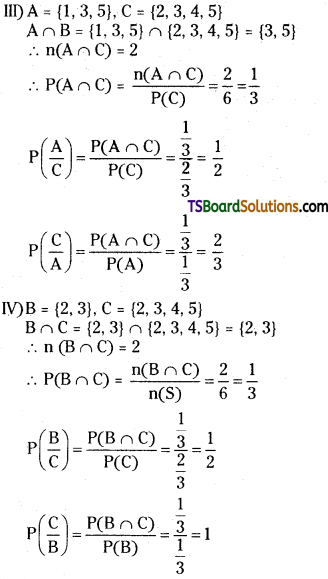
Question 37.
Suppose A and B are Independent events with P(A) = 0.6, P(B) = 0.7 then compute
I) P(A ∩ B)
II) P(A ∪ B
III) \(\mathbf{P}\left(\frac{\mathbf{B}}{\mathbf{A}}\right)\)
IV) \(\mathbf{P}\left(\mathbf{A}^{\mathbf{C}} \cap \mathbf{B}^{\mathbf{C}}\right)\) [May ‘14. Mar. ‘14] [AP – Mar.’ 17; TS – Mar. ‘18, May ‘16]
Solution:
A, B are independent events then
P(A ∩ B) = P(A) . P(B)
Given that, P(A) = 0.6, P(B) = 0.7
I) P(A ∩ B) = P(A) . P(B)
= 0.6 xO.7 = 0.42.
II) P(A ∪ B) = P(A) + P(B) – P(A ∩ B)
= P(A) + P(B) – P(A). P(B)
= 0.6 + 0.7 – (0.6) (0.7)
= 1.3 – 0.42 = 0.88
III) \(P\left(\frac{B}{A}\right)=\frac{P(A \cap B)}{P(A)}\)
= \(\frac{P(A) \cdot P(B)}{P(A)}\) = P(B) = 0.7
IV) \(P\left(A^C \cap B^C\right)=P(A \cup B)^C\)
= 1 – P(A ∪ B)
= 1 – 0.88 = 0.12.
Question 38.
The probability that Australia wins a match against india in a cricket game is given to be \(\frac{1}{3}\). If India and Australia play 3 matches what Is the probability that
I) Australia will loose all the 3 matches
II) Australia will win atleast one match. [May ’12]
Solution:
Suppose, A is the event at Australia winning the match.
P(A) = \(\frac{1}{3}\)
I) Probability that Australia will loose all the three matches
= \(P(\overline{\mathrm{A}}) \cdot P(\overline{\mathrm{A}}) \cdot P(\overline{\mathrm{A}})\)
= \(\frac{2}{3} \cdot \frac{2}{3} \cdot \frac{2}{3}=\frac{8}{27}\).
II) Probability that Australia will win atleast one match
= 1 – \(P(\overline{\mathrm{A}}) \cdot P(\overline{\mathrm{A}}) \cdot P(\overline{\mathrm{A}})\)
= \(1-\frac{8}{27}=\frac{19}{27}\).

Question 39.
In a shooting test, the probability of A, B, C hitting the targets are \(\frac{1}{2}\), \(\frac{2}{3}\) and \(\frac{3}{4}\) respectively. If all of them fire at the same target. Find the probability that
I) Only one of them hits the target
II) Atleast one of them hits the target
Solution:
Given that,
P(A) = \(\frac{1}{2}\)
⇒ P(\(\overline{\mathrm{A}}\)) = 1 – P(A)
= 1 – \(\frac{1}{2}\) = \(\frac{1}{2}\)
P(B) = \(\frac{2}{3}\)
⇒ P(\(\overline{\mathrm{B}}\)) =1 – P(B)
= 1 – \(\frac{2}{3}\) = \(\frac{1}{3}\)
P(C) = \(\frac{3}{4}\)
⇒ P(\(\overline{\mathrm{C}}\)) =1 – P(C)
= 1 – \(\frac{3}{4}\) = \(\frac{1}{4}\)
I) The probability that one of them hits the target
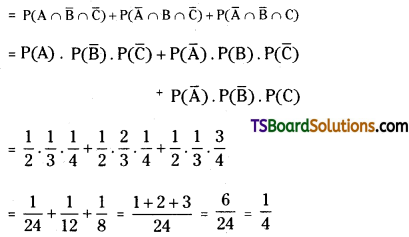
II) The probability that atleast one of them hits the target
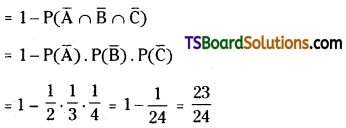
Question 40.
Define conditional events conditional probability. [TS – May 2015: March ‘11, 06, May 11, ’07]
Solution:
Conditional event:
If A, B are two events in a sample space then the event of happening B after the event A happening is called conditional event. It is denoted by \(\frac{B}{A}\).
Conditional Probabillty :
If A, B are two events in a sample space S and P(A) ≠ 0 then the probability of B after the event A has occurred ¡s called conditional probability of B given A. It is denoted by P(\(\frac{B}{A}\)).
We define P(\(\frac{B}{A}\)) = \(\frac{P(B \cap A)}{P(A)}\), P(A) ≠ 0.
Question 41.
A pair of dice is thrown. Find the probability that either of the dice shows 2 when their sum is 6.
Solution:
Let S be the sample space.
Let S be the sum to 6, when two dice are rolled.
S = {1, 5), (2, 4), (3, 3), (4, 2), (5, 1)}
∴ n(S) = 5
Let A be the event that either of the dice shows 2
∴ A = {(2, 4), (4, 2))
∴ n(A)= 2
∴ Required probability, P(A) = \(\frac{n(A)}{n(S)}=\frac{2}{5}\).

Question 42.
An urn contains 7 red and 3 black balls. 2 balls are drawn without replacement. What is the propability that the 2’ ball is red ¡fit is known that the 1 ball drawn is red? [Mar. ’05]
Solution:
Total number of balls in urn = 10
Red balls = 7
Black balls = 3
Let R1 be the event of drawing the first ball red and R2 be the event of drawing the second ball red.
The probability that the first ball drawn is red is P(R1) = \(\frac{{ }^7 \mathrm{C}_1}{{ }^{10} \mathrm{C}_1}=\frac{7}{10}\)
Now, after one red ball is drawn out. 6 red balls and three black balls remain in the urn.
The probability that the second ball is red it is known that the first ball drawn is red.
\(\mathrm{P}\left(\frac{\mathrm{R}_2}{\mathrm{R}_1}\right)=\frac{{ }^6 \mathrm{C}_1}{{ }^9 \mathrm{C}_1}=\frac{6}{9}=\frac{2}{3}\).
Question 43.
Let A and B be independent events with P(A) = 0.2, P(B) = 0.5. Find
I) \(\mathrm{P}\left(\frac{\mathrm{A}}{\mathrm{B}}\right)\)
II) \(\mathrm{P}\left(\frac{\mathrm{B}}{\mathrm{A}}\right)\)
III) P(A ∩ B)
IV) P(A ∪ B) [Mar. ‘12, ‘09, ‘06, May ‘11]
Solution:
Since, A and B are independent events then P(A ∩ B) = P(A) . P(B)
Given that,
P(A) = 0.2, P(B) = 0.5
I) \(\mathrm{P}\left(\frac{\mathrm{A}}{\mathrm{B}}\right)\) = P(A) = 0.2
II) \(\mathrm{P}\left(\frac{\mathrm{B}}{\mathrm{A}}\right)\) = P(B) = 0.5
III) P(A ∩ B) = P(A) . P(B)
= 0.2 × 0.5 = 0.01
IV) P(A ∪ B) = P(A) + P(B) – P(A ∩ B)
= P(A) + P(B) – P(A). P(B)
= 0.2 + 0.5 – 0.1 = 0.6.
Question 44.
Bag B1 contains 4 white and 2 black balls. Bag B2 contains 3 whIte and 4 black balls. A bag is drawn at random and a ball is choosen at random from it. What is the probability that the ball drawn is white? [March ’11, May ’11]
Solution:
Probability of selecting first bag = \(\frac{1}{2}\)
Probability of selecting second bag = \(\frac{1}{2}\)
Probability of getting a white ball from first bag = \(\frac{{ }^4 C_1}{{ }^6 C_1}=\frac{4}{6}=\frac{2}{3}\)
Probability of getting a white ball from second bag = \(\frac{{ }^3 \mathrm{C}_1}{{ }^7 \mathrm{C}_1}=\frac{3}{7}\)
Probability of drawing a white ball = \(\frac{1}{2} \cdot \frac{2}{3}+\frac{1}{2} \cdot \frac{3}{7}=\frac{1}{3}+\frac{3}{14}=\frac{23}{42}\).

Question 45.
Define mutually exclusive events and give an example. [May 2013]
Solution:
Mutually Exclusive Events:
Two events A, B in a sample space, S are said to be disjoint or mutually exclusive if A ∩ B = Φ
E.g.:
The events {1, 2}, {3, 5) are disjoint in the sample space, S = {1, 2, 3, 4, 5, 6}
Question 46.
Suppose there are 12 boys and 4 girls in a class if we choose 3 children one after another in succession at random, find the probability that all the 3 are boys.
Solution:
Total no. of children = 16
Boys = 12
Girls = 4
The probability ol selecting first child is boy is \(\frac{{ }^{12} \mathrm{C}_1}{{ }^{16} \mathrm{C}_1}=\frac{12}{16}=\frac{3}{4}\)
If the first child selected is boy, 15 children are left and 11 out of them are boys.
The probability that the second child selected is boy is \(\frac{{ }^{11} \mathrm{C}_1}{{ }^{15} \mathrm{C}_1}=\frac{11}{15}\)
If the first two children selected are boys, 14 children are left and 10 out of them are boys.
The probability that the third child selected is boy is \(\frac{{ }^{10} \mathrm{C}_1}{{ }^{14} \mathrm{C}_1}=\frac{10}{14}=\frac{5}{7}\)
Hence, by the multiplication theorem the required probability = \(\frac{3}{4} \cdot \frac{11}{15} \cdot \frac{5}{7}=\frac{11}{28}\).
Question 47.
‘A’ speaks truth In 75% of the cases and ‘B’ in 80% cases. What is the probability that their statements about an incident do not match? [AP & TS – Mar. 2016; May ’10, AP – Mar. 2019]
Solution:
Let A be the event that ‘A’ speaks truth about an incident.
P(A) = \(\frac{75}{100}=\frac{3}{4}\)
\(P\left(A^c\right)\) = 1 – P(A)
= 1 – \(\frac{3}{4}\) = \(\frac{1}{4}\)
Let B be the event that ‘B’ speaks truth about an incident
P(B) = \(\frac{80}{100}=\frac{4}{5}\)
\(P\left(B^c\right)\) = 1 – P(B)
= 1 – \(\frac{4}{5}\) = \(\frac{1}{5}\)
The probability that their statements about an incident do not match = \(P\left(A \cap B^C\right)+P\left(A^C \cap B\right)\)
Since A, B are independent events = \(P(A) \cdot P\left(B^C\right)+P\left(A^C\right) \cdot P(B)\)
= \(\frac{3}{4} \cdot \frac{1}{5}+\frac{1}{4} \cdot \frac{4}{5}\)
= \(\frac{3}{20}+\frac{1}{5}=\frac{3+4}{20}=\frac{7}{20}\).

Question 48.
A problem in Calculus is given to two students A and B whose chances of solving it are \(\frac{1}{3}\) and \(\frac{1}{4}\) respectively. Find the probability of the problem being solved if both of them try independently. [AP – Mar. ‘18, ‘15, May ‘15; Mar.’05, Board Paper]
Solution:
Let A be the event that the problem is solved by ‘A’.
P(A) = \(\frac{1}{3}\)
Let B be the event that the problem is solved by B’
P(B) = \(\frac{1}{4}\)
The probability of the problem being solved is
P(A ∪ B) = P(A) + P(B) – P(A ∩ B)
Since A, B are independent events = P(A) + P(B) – P(A) . P(B)
= \(\frac{1}{3}+\frac{1}{4}-\frac{1}{3} \cdot \frac{1}{4}\)
= \(\frac{1}{3}+\frac{1}{4}-\frac{1}{12}\)
= \(\frac{4+3-1}{12}=\frac{6}{12}=\frac{1}{2}\).
Question 49.
A and B toss a coin 50 times each simultaneously. Find the probability that both of them will not get tails at the same toss.
Solution:
Let E be the event that A and B both will not get tails at the same toss.
In each toss, we have the following 4 choices:
1) A : Head B : Head
2) A : Head B : Tall
3) A : Tail B : Head
4) A : Tail B : Tail
L.et S be the sample space.
There are 50 Trials.
The total no. of choices, n(S) = 4.4.4 …………………….4 (50 times) = 450
Let E be the event that A and B both will not get tails at same toss.
n(E) = 3.3.3. 3 (50 times) = 350
The probability that both of them will not get tails at the same toss.
P(E) = \(\frac{n(E)}{n(S)}=\frac{3^{50}}{4^{50}}=\left(\frac{3}{4}\right)^{50}\)

Question 50.
If A and B are independent events of a random experiment then show that A and BC are also independent. [Oct. ’99], [TS – May 2016]
Solution:
Since, A and B are independent events then
P(A ∩ B) = P(A) . P(B)
Now, \(P\left(A^C \cap B^C\right)=P(A \cup B)^C=P(\overline{A \cup B})\)
= 1 – P (A ∪ B)
= 1 – [P(A) + P(B) – P(A ∩ B)]
= 1 – P(A) – P(B) . P(A ∩ B)
= 1 – P(A) – P(B) + P(A) . P(B)
= 1 – P(A) – P(B) (1 – P(A))
= (1 – P(A)) (1 – P(B))
= \(P\left(A^C\right) \cdot P\left(B^C\right)\)
∴ \(A^C\) and \(B^C\) are independent.
![]()
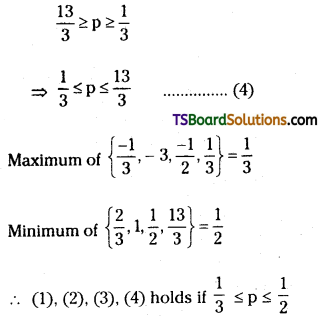
![]()
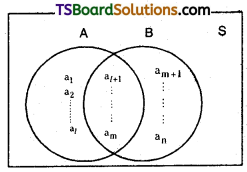
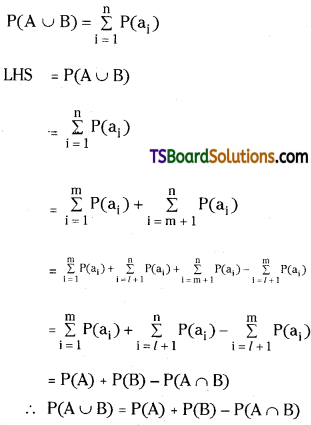
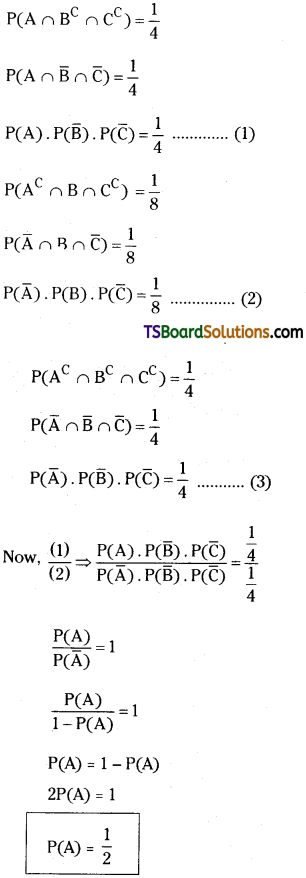
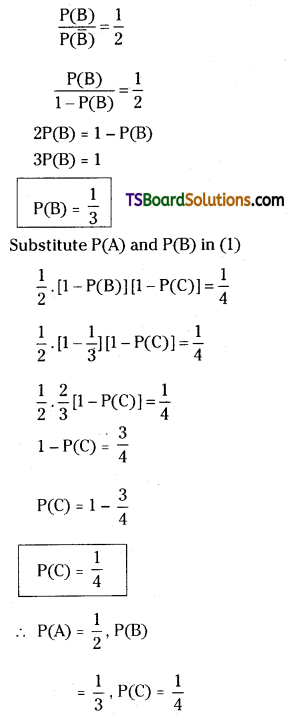
![]()
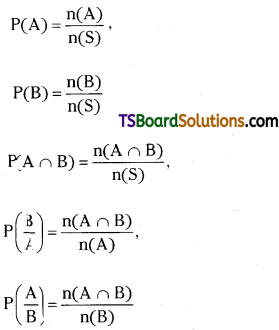
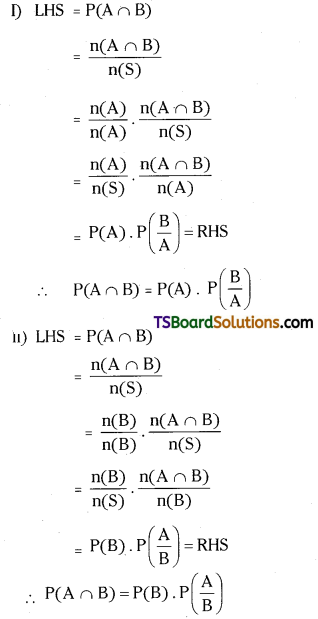
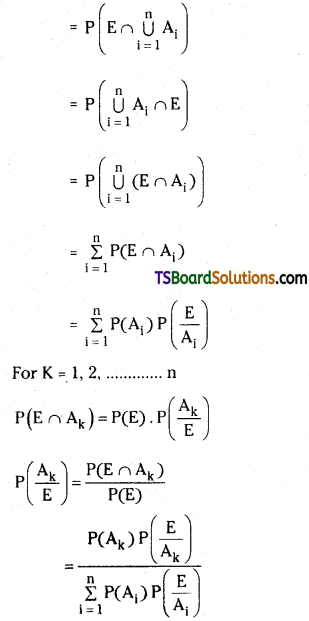
![]()
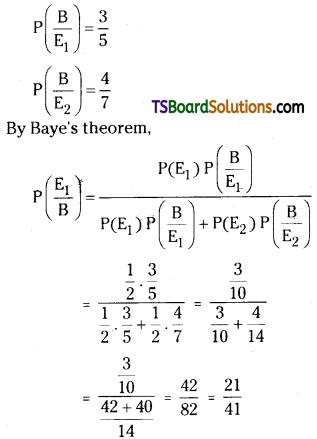

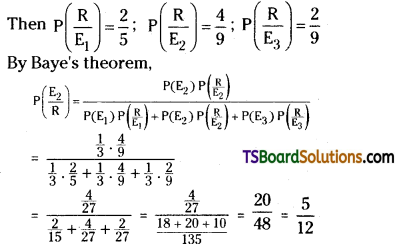
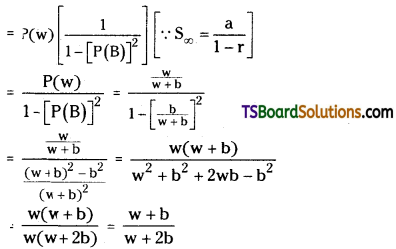
![]()
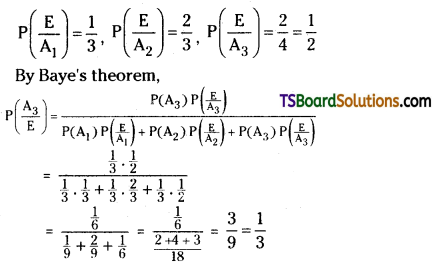
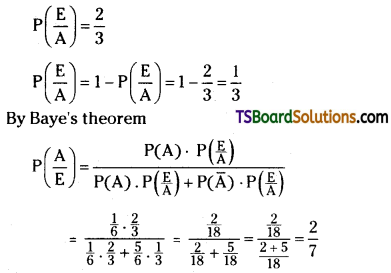
![]()


